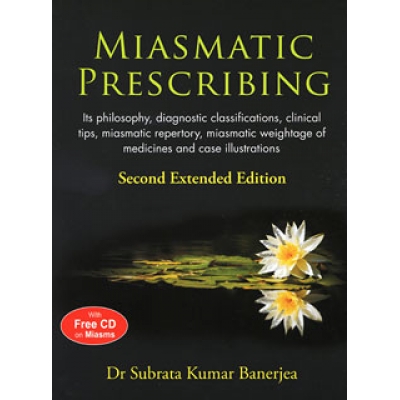
Miasmatic Prescribing
By Dr. Banerjea
Second extended edition 2010 with Free CD on Miasms
There are six main sections in the book, beginning with the philosophy of miasm concept (Part I), followed by miasmatic diagnostic classifications (Part II), miasmatic diagnosis of clinical classifications (Part III), miasmatic ancestral tips and repertory (Parts IV and V), and finally the miasmatic weightage of medicines (Part VI) together with a useful Index.
Review from the Homeopath (by Stewart Sandison):
Miasmatic Prescribing is largesized to accommodate the comparative charts and tables that make up the bulk of the text, so the good news is that the philosophy chapter is only 39 pages of the 270. There are six parts to the book, and each one is set out in headed sections, with the idea of facilitating a miasmatic analysis of your cases.
The philosophy comes first, as it should; it is a summary of the Banerjea thinking on miasms, based on Hahnemann (with quotations from Kent and other classical authors), and upon Dr Banerjea's vast familial clinical experience.
Parts two and three comprise diagnostic charts comparing various symptoms in a miasmatic way, with general observations and specific repertory-order symptoms.
Part four is entitled Miasmatic Ancestral Tips: - here we are given pearls of wisdom from the Banerjeas, in the form of comparative tables on subjects from jogging to AIDS (four pages alone).
Part five is a miasmatic repertory, with ticked boxes for each symptom under the four miasmatic headings, plus an extra box if the symptom denotes a mixing of the miasms. This is limited by space, of course, but could be very useful in its own right.
Part six is a table showing the miasmatic weighting of remedies. It uses a grading system from zero to three, and it covers more than 400 remedies.
